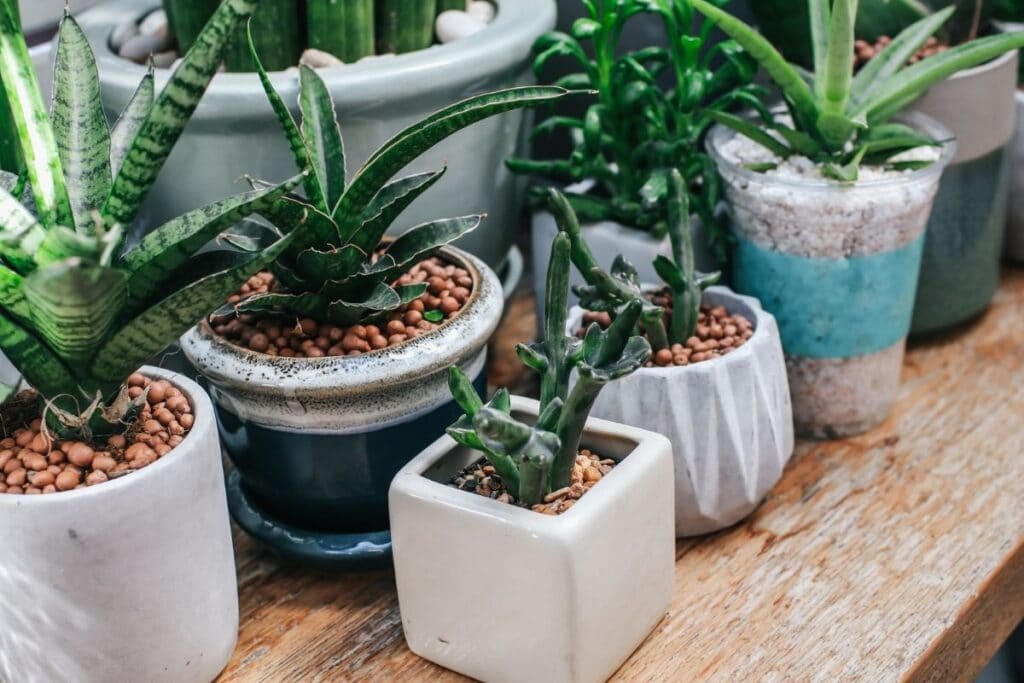Despite their known resiliency to harsh and unforgiving environments, succulents are still susceptible to a number of pest infestations. The fleshy leaves of a succulent plant mean water-filled, nutrient-rich cells, the very thing that attracts these pesky little insects or fungus such as white fuzzy mold.
If the conditions are met, they will surely make a home out of the nooks and crannies of any succulent.
Whether experienced or not, most succulent growers will go through the occasional pest attack, and there is nothing to do but try to control the infestation. Pest infestation in succulents can become very damaging and eventually kill the plant if not controlled immediately.
To help with diagnosis and eradication, we compiled some of the common pests that can cause damage to your succulents.
Mealybugs
These insect pests are small, about 2.5 mm in length. They have an unmistakable white, cottony coating that insulates and protects them from predators. They stay in these cloud-like fortresses happily sucking on the plant sap.
Succulents infested with mealybugs will show symptoms of delayed growth and loss of turgidity or fleshiness. They could even become susceptible to diseases due to the honeydew that these pests produce.
While these insects can be easily identified because they mostly feed on the leaves and stem, some mealybugs prefer to attack the roots. This is why you need to know how to get rid of mealybugs on succulents.
Regardless of where they attack, mealybugs can be easily eradicated by wiping with cotton dipped in rubbing alcohol. A systemic insecticide can also be applied during the plant’s growing season to further prevent spread (1,2,3).
Aphids

Yellow, green, or black in color, these small, soft-bodied insects feed on the plant sap causing stunted growth and weakening. And like mealybugs, they also produce honeydew that attracts ants and fungal infections.
Aphid infestation can be controlled simply by washing the infested plants or rubbing using a cotton swab dipped in alcohol. Spraying with diluted neem oil also works (4).
Scale Insects
There are thousands of types of scale insects but the one that is most likely to infest succulents are the armored ones. These insects are covered with a scale armor that protects it from predators and pesticides.
Scale insects multiply very fast and can easily cover a whole collection if left uncontrolled. They can cause stunted growth and weakening of the plant. These pests thrive in dark surroundings and can be found on the underside of leafy succulents and other shady parts of the plant.
Scale insects can be controlled the same way as mealybugs and aphids. Simply wipe the scale insects off with cotton swabs dipped in alcohol or use a systemic pesticide applied when the plant is growing proficiently (1,2,3).
Red Spider Mites

These are very small, almost microscopic insects. They look like dust particles to the naked eye and can be easily looked over. Red spider mites can only be identified when they have multiplied in number, at which point they will have formed webbing that can cover whole plants.
Infested succulents will develop yellow to brown spots, particularly on young growths. Plants will also become weak and susceptible to diseases
Red spider mites do not like humidity and can be easily eradicated by washing the plant, however, succulents are also not a fan of being wet so be careful not to soak your succulents. If you wish to use pesticides, note that spider mites require a specific miticide and will not be easily controlled with most insecticides (1,2).
Eriophyid Mites
Also known as aloe mite, aloe wart mite, or aloe gall mite, eriophyid mites are very small, visible only under a microscope. They are worm-like in appearance with two pairs of legs and spread easily through the wind.
Eriophyid mites target Aloe and Haworthia plants. The presence of these mites is not easy to identify and the infestation will only be diagnosed once the plant is exhibiting symptoms that are permanently damaging.
Infested plants will exhibit galls caused by a chemical injected by these insects. The galls will grow on the topside of the leaves, flowers, and new growths. On aloes, the galls can form cancer-like structures that can severely disfigure the plant.
Since the damage done by eriophyid mites is irreversible, the best way to control infestation is to dispose of the infested plant so the mites will not spread to other plants. The application of miticide to plants in the vicinity will also help prevent further spread (5,6).
Western Flower Thrips
These pests are very small, with the adults measuring only up to about 1 mm in length. Introduced in the UK in the late 1980s, western flower thrip adults are yellow-brown in color with narrow hairy fringed wings, but they are not the main culprit for the damage, their larvae, which are half the size of the adult are.
Infecting mostly Lithops plants, the larvae feed on the plant epidermis, causing extensive damage to the plant’s beautiful stone-like leaves. Western flower thrips have a short life cycle which means they can easily damage a whole succulent collection in favorable conditions.
These pesky insects can be controlled using insecticides or through biological control but often as a last resort. Insecticide treatment has to be done three times in weekly intervals to achieve good control of these pests (3).
White Flies
These are small, white, flying insects which are common problems for leafy succulents. They are very stealthy, hiding under the leaves and can only be identified when the plant is disturbed.
As with other insect pests, they suck on the plant sap, causing damage to the plant and even allowing the fungal growth and diseases.
Eradication can be difficult even through the application of a suitable insecticide that some gardeners resort to using biological controls, e.g. ladybug and lacewing larvae (3).
Fungus Gnats
Also known as sciarid flies, these pests are a threat to succulents, especially young plants. Fungus gnat has a similar appearance to fruit flies. These insects thrive in humid conditions and are attracted to decaying plant matter.
Prolific in autumn, they lay their eggs in humus-rich soil where the larvae will hatch and eat young plant roots, even the whole plant. They are difficult to identify unless present in large numbers. Infested plants will show symptoms of stunting and failure to thrive.
Although the diagnosis can be late, once identified, fungus gnats can be controlled with insecticide or larvicide application (7).
Vine Weevil
While the adults can cause damage to the leaves, the grubs of vine weevils are the root cause of damage to many succulent collections. These grubs bore into the stems and feed on the plant roots.
Crassula, Echeveria, and Kalanchoe plants are the most susceptible to these pests. Infection is often diagnosed late when the infected plant is completely rootless and topples over. Looking at the pot contents will reveal wriggling white larvae in the soil.
Once diagnosed, eradication should be done immediately using soil drench treatments or you could just simply squish them (3).
Slugs and Snails

These gastropods are a particular problem for outdoor succulents. They can spread rapidly especially during the rainy season, attacking new growth and flower buds.
They can be identified by bite marks around the edges of the succulent leaves and the unmistakable slime trails they leave behind.
Slugs and snails can be easily eradicated as easily as they can be identified. They can be picked off by hand or organically controlled using slug pellets with an iron phosphate. These baits are safe for humans and pets and will become fertilizer to the plant if not eaten by the slugs, so there is no need for worrying (1,2,3).
Note: While many commercial pesticides can be used for other houseplants, they can be harmful and cause damage to succulents. Be sure to read the label and application procedures before using them on your plants.
If unsure whether to use fertilizer or not, a patch-test can be done by applying the product to a small area and seeing if it will cause damage to the plant.
I hope you enjoy reading these succulent pest control tips. To learn more about growing succulents, check our article on succulent propagation.
References
Reference List:
(1) Asakawa S., Bagnasco J., Buchanan S. “Planting Designs for Cactus & Succulents: Indoor and Outdoor Projects for Unique, Easy-Care Plants–in All Climates”. Cool Springs Press. 2014. PP 161-165.
(2) Bagnasco J., Reidmuller Jr. B. 2017. “Success with Succulents: Choosing, Growing, and Caring for Cactuses and Other Succulents” Cool Springs Press. PP 86-87.
(3) Charles G. “Cacti and Succulents: An illustrated guide to the plants and their cultivation”. Crowood. 2014.
(4) Singh D., Davidson J. “Introduction to Succulents and Cacti – Cacti Culture for Newbies”. Mendon Cottage Books. 2019. PP 55-63.
(5) Baldwin D. “Designing with Succulents”. Timber Press. 2017. P. 139 (aloe mite)
(6) “Aloe Mite”. San Marcos Growers. 2020.
(7) Bailey F., Allaway Z. “Practical Cactus and Succulent Book: How to Choose, Nurture, and Display 200 Cacti and Succulents”. Penguin. 2019. P 215.
Close
Image by [email protected]/depositphotos







